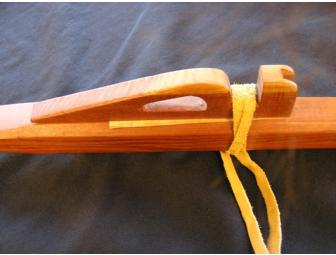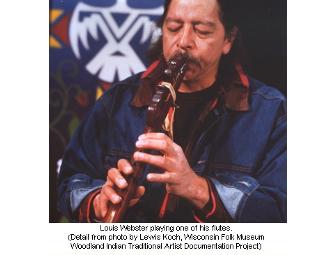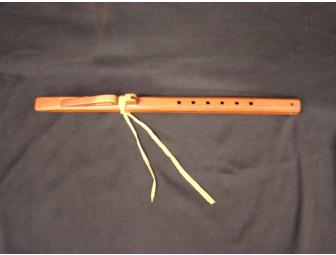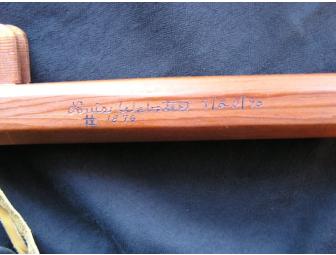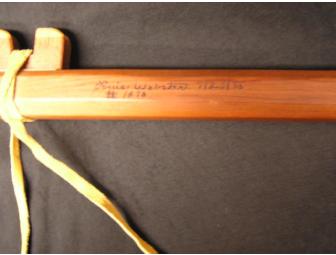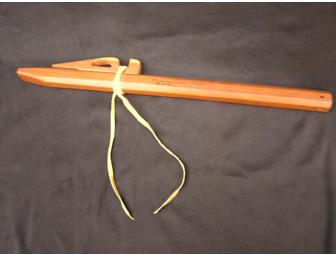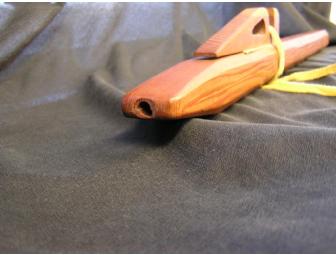Music and instruments
Handcarved Red Cedar Courting Flute by Louis Webster and played by Andrew Thomas
- Item Number
- 195
- Estimated Value
- 400 USD
- Sold
- 120 USD to rblatz
- Number of Bids
- 6 - Bid History
Item Description
Traditional style handcrafted red cedar flute with birch bark channel under a cedar carved block shaped to form a stylized bird head held to the flute with a leather strap. 6 holes with directional holes at the base to represent the four directions. Signed by Louis Webster dated 7/20/96 and numbered #187. 21 3/4" in length. Pentatontacally scaled flute. Played by internationally known flute player, Andrew Thomas.
The voice of the flute is a prayer without words. And the flute teaches the player to play.
Native American courting flute carved by Louis Webster, of Menominee, Stockbridge, Potawatomi and Oneida descent. He lives on the Oneida Reservation.
Born in Green Bay, Wisconsin in 1949 of mixed Woodland heritage, Webster was raised on the Menominee reservation and is a member of Bird Clan. Growing up surrounded by music, with his grandfather, father and mother all playing musical instruments, Webster knew from an early age that he wanted to be a musician. It was a Native American song, music, and dance course he took at the University of Wisconsin-Milwaukee in the 1970s that piqued his interest in the courting flute. As part of the class, the instructor, ethnomusicologist Edward Wapp Wahpeconiah, brought in instruments from around the globe, including a wooden flute. After closely studying the flute Webster decided he could make one himself, triggering a lifelong passion for its production and playing.
The flute, according to Webster, is not a precise instrument and each one is different. The length of the flute helps determine its key and players must use a different flute to play songs in various keys (much like the harmonica). The noting system is created by the size and spacing of the tone holes. For Webster, the flute and the music it makes represent something more spiritual than just sounds. Webster's flutes are deeply symbolic, with the tone holes representing the Earth, the heavens, life, and love. The flute player's breath is believed to give the flute its life. Every flute has it's own voice and song.
Addressing the spiritual nature of flutes Webster said, “People can take inanimate objects and make them instruments of power. Same with the flute. It’s your will and your belief that gives something power. Some people expect to find nirvana by getting one of these flutes. And in some cases it works. But it doesn’t if your heart really isn’t there to begin with. If you really let the flute get inside you, it can do wonderful things for your being.”
Thanks to Dennis Hawk for background information on his teacher, Louis Webster.
Andrew Thomas is a contemporary Dineh (Navajo Nation) flute player. He was born and raised in Rock Spring Chapter near Gallup, New Mexico. He is self-taught, and plays music composed from the heart. He has chosen the flute’s voice to express his way of life, heritage and culture. He can be contacted through Facebook.
Item Special Note
After the auction closes, items will be shipped to the winning bidder and actual shipping charges (including insurance) will be added to the total bid, unless bidder chooses pickup options listed in your winning bid confirmation at the close of the auction.
Donated By:
KUNM stores data...
Your support matters, so KUNM would like to use your information to keep in touch about things that may matter to you. If you choose to hear from KUNM, we may contact you in the future about our ongoing efforts.
Your privacy is important to us, so KUNM will keep your personal data secure and KUNM will not use it for marketing communications which you have not agreed to receive. At any time, you may withdraw consent by emailing Privacy@frontstream.com or by contacting our Privacy Officer. Please see our Privacy Policy found here PrivacyPolicy.

